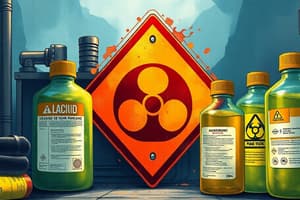Podcast
Questions and Answers
Which of the following is required by the Hazard Communication Standard? (Select all that apply)
Which of the following is required by the Hazard Communication Standard? (Select all that apply)
- Labels and safety data sheets must be prepared in a standardized format
- Employers must have a written hazard communication program
- Employers must implement an employee training program regarding chemical hazards and protective measures
- All of the above (correct)
The two GHS signal words are
The two GHS signal words are
- Caution and toxic
- Danger and caution
- Warning and danger (correct)
- Toxic and danger
According to this portion of the SDS label, which hazard classes apply to this chemical?
According to this portion of the SDS label, which hazard classes apply to this chemical?
- Flammable, health hazard, irritant (correct)
- Oxidizer, health hazard, irritant
- Flammable, corrosive, explosive
- Gas under pressure, corrosive, irritant
Which one of the following is information required on a Secondary Label?
Which one of the following is information required on a Secondary Label?
In GHS Hazard Classification, which of the following categories is the highest level of hazard?
In GHS Hazard Classification, which of the following categories is the highest level of hazard?
A chemical that can cause allergic reactions is called a(n):
A chemical that can cause allergic reactions is called a(n):
Which of the following is true about Safety Data Sheets (SDS)?
Which of the following is true about Safety Data Sheets (SDS)?
Which of the following pictograms indicate fatal or toxic acute toxicity?
Which of the following pictograms indicate fatal or toxic acute toxicity?
True or False: Hazard Statements and Codes are standardized and not subject to variation.
True or False: Hazard Statements and Codes are standardized and not subject to variation.
Flashcards are hidden until you start studying
Study Notes
Hazard Communication Standard (HazCom)
- Employers must establish a written hazard communication program, train employees on chemical hazards, and prepare labels and safety data sheets (SDS) in a standardized format.
- All requirements listed are mandated by the HazCom standard.
GHS Signal Words
- The two signal words in the Globally Harmonized System (GHS) for indicating hazard severity are "warning" and "danger."
Chemical Hazard Classes
- Common hazard classes for chemicals include flammable, health hazard, and irritant, which must be clearly identified on SDS labels.
Secondary Label Requirements
- Secondary labels must include the full name and concentration of the chemical, ensuring clarity in chemical identification.
GHS Hazard Classification
- Category 1 represents the highest level of hazard in GHS classification, indicating a more severe risk compared to other categories.
Allergic Reactions
- A chemical that triggers allergic reactions is classified as a sensitizer, distinguished from irritants and corrosives.
Safety Data Sheets (SDS)
- SDS must adhere to a standardized 16-section format, ensuring comprehensive information is readily available across all relevant employee groups.
Pictograms for Acute Toxicity
- The skull and crossbones pictogram is used to indicate fatal or toxic acute toxicity hazards.
Hazard Statements and Codes
- Hazard statements and codes are standardized across the GHS system, ensuring consistency and reducing confusion in communication.
Studying That Suits You
Use AI to generate personalized quizzes and flashcards to suit your learning preferences.




